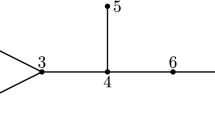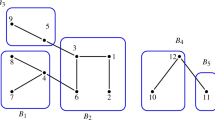Abstract
It is well-known that the core on several domains of cooperative transferable utility (TU) and nontransferable utility (NTU) games is characterized by various combinations of axioms containing some versions of the reduced game property, of its converse, or of the reconfirmation property with respect to the Davis–Maschler reduced game. We show that these characterizations are still valid for games with communication structures à la Myerson when using the notion of the reduced communication structure that establishes a new link between two inside players if they can communicate via outside players. Thus, it is shown that, if communication structures are present, the core may still be characterized on balanced TU games, on totally balanced TU games, on NTU games with a nonempty core, on the domains of all TU or NTU games, and on several other interesting domains of TU and NTU games. As a byproduct we construct, for any NTU game with communication structure, a certain classical NTU game with the same core that may be regarded as its Myerson restricted NTU game.
Similar content being viewed by others
Notes
Note that \(\nu (N,v,g)\) may not coincide with \(\nu (N,v/g)\) in general already for \(|N|=3\) as shown by an example Khmelnitskaya and Sudhölter (2013, p. 297), but using Kohlberg ’s (1971) characterization of the (pre)nucleolus by balanced collections of coalitions it may be deduced that \(\nu (N,v,g)=\nu (N,v/g)\) for all balanced (N, v, g).
When applied to sets, the “+” denotes the “Minkowski sum”, i.e., \(x+\mathbb R^S_+=\{x+y\mid y\in \mathbb R^S_+\}\).
References
Albizuri MJ, Zarzuelo JM (2009) Conference structures and consistency. Discrete Math 309:4969–4976
Bilbao JM (1999) The core of games on convex geometries. Eur J Oper Res 119:365–372
Billera LJ, Bixby RE (1973) A characterization of polyhedral market games. Int J Game Theory 2:253–261
Bondareva ON (1963) Some applications of linear programming methods to the theory of cooperative games. Problemi Kibernitiki 10:119–139
Davis M, Maschler M (1965) The kernel of a cooperative game. Naval Res Logist Q 12:223–259
Faigle U (1989) Cores of games with restricted cooperation. Zeitschrift für Operations Research-Mathematical Methods of Operations Research 33:405–422
Grabisch M, Sudhölter P (2012) The bounded core for games with precedence constraints. Ann Oper Res 201:251–264
Herings P, van der Laan G, Talman A, Yang Z (2010) The average tree solution for cooperative games with communication structure. Games Econ Behav 68:626–633
Hwang Y-A, Sudhölter P (2001) Axiomatizations of the core on the universal domain and other natural domains. Int J Game Theory 29:597–623
Keiding H, Thorlund-Petersen L (1987) The core of a cooperative game without side payments. J Optim Theory Appl 54:273–288
Khmelnitskaya A, Sudhölter P (2013) The prenucleolus and the prekernel for games with communication structures. Math Methods Oper Res 78:285–299
Kohlberg E (1971) On the nucleolus of a characteristic function game. SIAM J Appl Math 20:62–66
Llerena F (2007) An axiomatization of the core of games with restricted cooperation. Econ Lett 95:80–84
Maschler M, Peleg B, Shapley LS (1972) The kernel and bargaining set for convex games. Int J Game Theory 1:73–93
Myerson RB (1977) Graphs and cooperation in games. Math Oper Res 2:225–229
Myerson RB (1980) Conference structures and fair allocation rules. Int J Game Theory 9:169–182
Peleg B (1985) An axiomatization of the core of cooperative games without side payments. J Math Econ 14:203–214
Peleg B (1986) On the reduced game property and its converse. Int J Game Theory 15:187–200
Peleg B (1989) An axiomatization of the core of market games. Math Oper Res 14:448–456
Predtetchinski A, Herings PJ-J (2004) A necessary and sufficient condition for nonemptiness of the core of a non-transferable utility game. J Econ Theory 116:84–92
Pulido MA, Sánchez-Soriano J (2006) Characterization of the core in games with restricted cooperation. Eur J Oper Res 175:860–869
Pulido MA, Sánchez-Soriano J (2009) On the core, the Weber set and convexity in games with a priori unions. Eur J Oper Res 193:468–475
Scarf HE (1967) The core of an \(n\)-person game. Econometrica 35:50–69
Schmeidler D (1969) The nucleolus of a characteristic function game. SIAM J Appl Math 17:1163–1170
Serrano R, Volij O (1998) Axiomatizations of neoclassical concepts for economies. J Math Econ 30:87–108
Shapley LS (1967) On balanced sets and cores. Naval Res Logist Q 14:453–460
Sobolev AI (1975) The characterization of optimality principles in cooperative games by functional equations. In: Vorobiev NN (ed) Mathematical methods in the social sciences, Vilnius, vol 6. Academy of Sciences of the Lithuanian SSR, pp 95–151 (in Russian)
Sudhölter P, Peleg B (2002) A note on an axiomatization of the core of market games. Math Oper Res 27:441–444
Tadenuma K (1992) Reduced games, consistency, and the core. Int J Game Theory 20:325–334
Author information
Authors and Affiliations
Corresponding author
Additional information
The authors are grateful to an anonymous referee and an associate editor of this journal for their detailed comments that helped to improve the writing of this paper. This research was supported by the Spanish Ministerio de Ciencia e Innovación under project ECO2012-33618, co-funded by the ERDF. Moreover, the first author was supported by the Basque Country University (UFI11/51 and GIU13/31), and the second author was supported by The Danish Council for Independent Research|Social Sciences under the FINQ project (Grant ID: DFF-1327-00097).
Rights and permissions
About this article
Cite this article
Albizuri, M.J., Sudhölter, P. Characterizations of the core of TU and NTU games with communication structures. Soc Choice Welf 46, 451–475 (2016). https://doi.org/10.1007/s00355-015-0924-1
Received:
Accepted:
Published:
Issue Date:
DOI: https://doi.org/10.1007/s00355-015-0924-1




